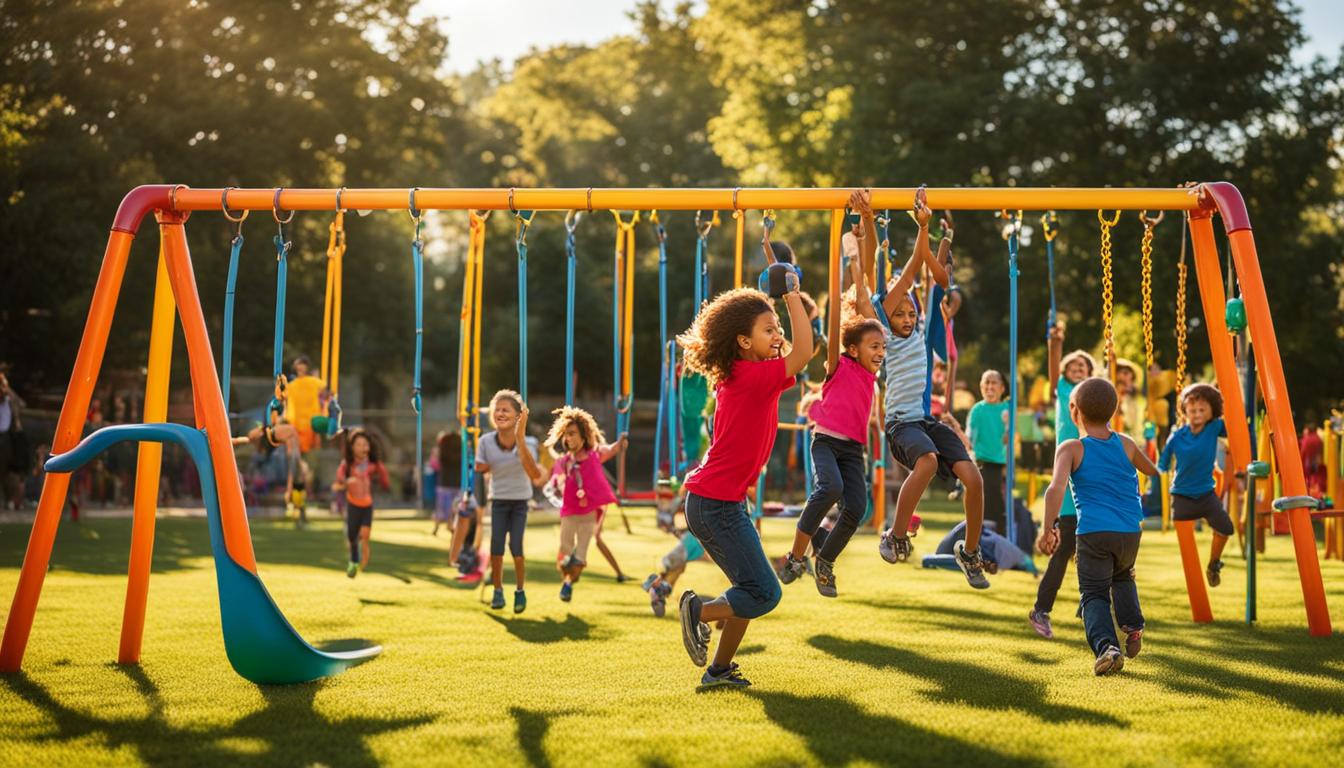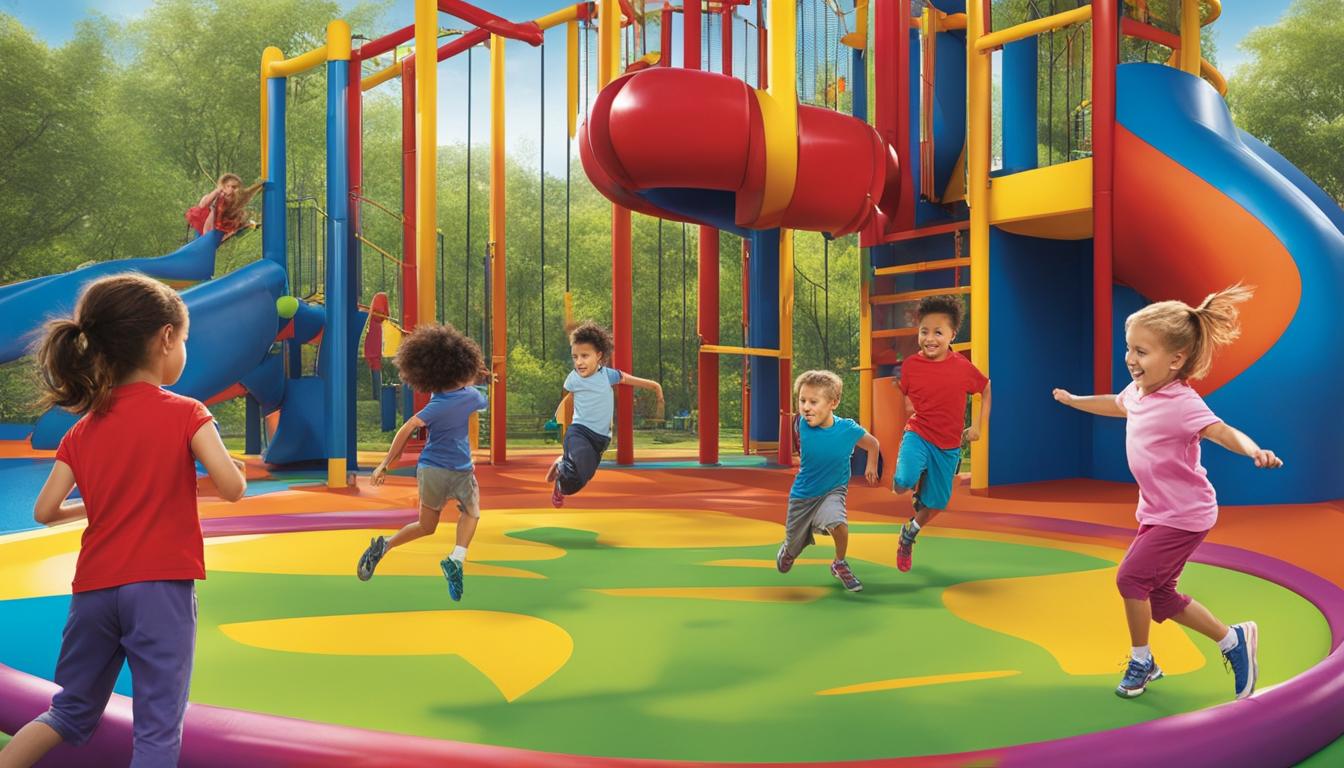Good nutrition and regular exercise are essential for children’s growth, development, and overall well-being. In today’s world, many children lack access to proper nutrition and don’t engage in enough physical activity, which can have long-term consequences for their health.
Promoting movement in children is crucial to establish healthy habits from an early age. Encouraging kids fitness not only leads to better academic performance but also improves their mental and behavioral well-being. It reduces the risk of chronic illnesses and sets the foundation for a lifetime of healthy behavior.
Key Takeaways:
- Fitness for children is important for their growth, development, and overall well-being.
- Encouraging healthy habits early can lead to better academic performance and improved mental and behavioral well-being.
- Kids fitness reduces the risk of chronic illnesses and promotes long-term healthy behavior.
- Promoting movement in children is crucial for establishing a lifetime of healthy habits.
- Parents and caregivers play a significant role in encouraging fitness and promoting healthy habits in children.
The Benefits of Good Nutrition and Exercise for Kids
Good nutrition and exercise have numerous benefits for children, promoting their overall wellness and setting the foundation for a healthy future. When children adopt healthy habits from an early age, it positively impacts their physical, mental, and emotional well-being.
Fueling Healthy Brain Development
Proper nutrition and regular exercise support healthy brain development in children. A well-balanced diet provides essential nutrients that enhance cognitive function, memory, and concentration. By nourishing their bodies with nutrient-dense foods, children can thrive academically and reach their full learning potential.

Building Strong Bodies and Preventing Chronic Illnesses
Engaging in regular physical activity helps children build strong muscles and bones, maintain a healthy weight, and reduce the risk of chronic illnesses. Physical exercise strengthens the cardiovascular system and boosts the immune system, protecting children from diseases such as heart disease, diabetes, and obesity. Additionally, exercise promotes healthy growth and development, improving motor skills and coordination.
Promoting Emotional Well-being and Self-esteem
Good nutrition and exercise contribute to children’s emotional well-being and self-esteem. Physical activity releases endorphins, which are natural mood-boosting hormones, helping children feel happier and more confident. Regular exercise also improves sleep quality, reduces stress and anxiety, and enhances emotional regulation, allowing children to better manage their emotions and navigate challenges.
In conclusion, instilling healthy habits in children, including proper nutrition and regular exercise, is essential for their overall well-being. By fueling their bodies with nutritious foods and incorporating physical activity into their daily routines, parents and caregivers can support children’s healthy growth, development, and emotional well-being.
Factors Affecting Eating and Exercise Habits in Children
Various factors can influence children’s eating and exercise habits, shaping their overall health and well-being. Understanding these factors is essential for parents, caregivers, and educators to promote healthy behaviors and establish lifelong habits in children.
The Home Environment
The home environment plays a significant role in shaping children’s eating and exercise habits. Limited access to nutritious foods can contribute to inadequate nutrition, while a lack of opportunities for physical activity can lead to a sedentary lifestyle. It is crucial for parents to provide a supportive environment by offering a wide variety of healthy foods, making them easily accessible, and encouraging regular physical activity through active play or participation in sports.
Media Influences
Media influences, particularly advertising of unhealthy foods targeted at children, can significantly impact their eating habits. Constant exposure to advertisements for sugary snacks and processed foods can create cravings and preferences for these unhealthy options. Parents should limit children’s exposure to such advertisements and encourage critical thinking about marketing tactics. It is important to educate children about the importance of making healthy food choices and to involve them in meal planning and preparation to foster a positive relationship with nutritious foods.
School and Neighborhood Environments
The school and neighborhood environments also play a role in children’s eating and exercise habits. Unhealthy school meals, limited recess and physical education time, and a lack of access to parks and recreational facilities can hinder children’s ability to engage in healthy behaviors. Advocacy for improved nutrition standards, increased physical activity opportunities, and the creation of safe and accessible play spaces can help create environments that support children’s overall health and well-being.
Creating an environment that promotes healthy eating and regular physical activity is essential for children’s overall well-being. By addressing these factors and implementing strategies to overcome barriers, parents, caregivers, and communities can empower children to develop healthy habits that last a lifetime.
The Role of Parents and Caregivers in Establishing Healthy Habits
Parents and caregivers play a crucial role in promoting and establishing healthy habits in children. As role models, they have the opportunity to inspire good nutrition and regular exercise through their own behaviors. By prioritizing their own health and well-being, parents and caregivers demonstrate to children the importance of making healthy choices.
Leading by Example
Children often imitate the behaviors they see in their parents and caregivers, so it’s essential for adults to engage in regular exercise themselves. Whether it’s going for a family walk, playing a game of catch, or participating in a dance party, involving children in physical activities can be both fun and beneficial. By actively participating in these activities, parents and caregivers reinforce the importance of exercise and inspire children to incorporate movement into their daily lives.
Establishing Boundaries
Parents and caregivers can also act as gatekeepers by controlling food access and monitoring diet and exercise. By providing a variety of nutrient-dense foods and limiting the availability of sugary and processed snacks, parents can help shape children’s taste preferences and promote healthier eating habits. Setting boundaries around screen time and ensuring dedicated time for physical activity are also vital in establishing healthy habits. Creating a schedule that includes regular exercise and limiting sedentary activities can help children develop a lifelong habit of being active.
Advocating for Change
In addition to being role models and setting boundaries, parents and caregivers have the power to advocate for changes in their communities, schools, and child care settings. By actively participating in school wellness committees, attending parent-teacher meetings, and communicating with policymakers, parents can advocate for healthier environments that promote movement in children. This can include advocating for increased physical education time, access to safe, well-maintained recreational facilities, and nutritious options in school meals.

Acting Boldly to Change Diet and Exercise
When it comes to promoting children’s fitness and encouraging movement, parents and caregivers play a crucial role in acting boldly to change diet and exercise habits. By implementing simple yet effective strategies, they can help children establish a foundation for a healthy lifestyle.
Providing Nutrient-Dense Foods and Limiting Sugary and Processed Foods
One of the key steps in changing diet habits is to provide children with nutrient-dense foods. By offering a variety of fruits, vegetables, whole grains, and lean proteins, parents and caregivers can ensure that children receive essential vitamins and minerals. It’s important to limit the consumption of sugary and processed foods, as these can contribute to weight gain and other health issues.
“By introducing children to new healthy foods and involving them in meal preparation, parents and caregivers can make the process fun and engaging,” says nutrition expert Dr. Lisa Johnson.
Promoting Regular Physical Activity
Another important aspect of encouraging movement in children is promoting regular physical activity. Engaging in activities such as outdoor play, family walks, or sports not only helps children develop strong muscles and bones but also improves their cardiovascular health and overall well-being. It is essential to limit sedentary screen time and create a safe environment that encourages physical activity.
By acting boldly to change diet and exercise, parents and caregivers can instill healthy habits in children that will benefit them throughout their lives.

Encouraging Healthy Eating with MyPlate
One effective tool that parents and caregivers can use to encourage healthy eating habits in children is MyPlate. Developed by the U.S. government, MyPlate provides a visual representation of a balanced diet that includes fruits, vegetables, grains, protein, and dairy. By following the guidelines of MyPlate, parents and caregivers can plan meals that provide the recommended servings from each food group, ensuring that children receive the necessary nutrients for their growth and development.
Incorporating MyPlate into meal planning can be a fun and educational experience for the whole family. By involving children in the process, they become more engaged and willing to try new foods. Parents can ask children to help choose fruits and vegetables of different colors to make their plates more appealing and diverse. Additionally, parents can encourage children to participate in meal preparation, such as washing and cutting fruits and vegetables or assembling their own healthy snacks.
“MyPlate has been a game-changer for my family. It provides a simple and practical way to ensure that my children are getting a balanced diet. We have fun filling our plates with a variety of colorful fruits and vegetables, and my kids have become more adventurous eaters!” – Maria, parent
By using MyPlate as a guide, parents and caregivers can create a positive and supportive eating environment where children develop healthy habits that will benefit them throughout their lives. Emphasizing the importance of balanced meals and involving children in the decision-making process helps to promote children’s wellness and encourages them to make healthier food choices.

Promoting Movement in Children
In addition to healthy eating, it is crucial to promote physical activity in children to support their overall well-being. Regular exercise helps children to develop strong muscles and bones, maintain a healthy weight, and improve their cardiovascular fitness. It also enhances their mental and emotional well-being, boosts their self-esteem, and promotes better sleep patterns.
To encourage movement in children, parents and caregivers can provide opportunities for outdoor play and engage in activities that the child enjoys. Whether it’s riding a bike, playing tag, or joining a sports team, finding activities that children find enjoyable will increase their motivation to participate. Additionally, setting aside dedicated time for physical activity and limiting sedentary screen time are essential in promoting an active lifestyle.
- Take family walks or bike rides in the park.
- Encourage children to participate in organized sports or physical education classes.
- Create a safe environment for active play at home.
- Limit screen time and encourage outdoor play.
By incorporating these strategies into daily routines, parents and caregivers can help children establish a lifelong habit of staying active. By promoting movement in children, parents and caregivers contribute to their overall health and well-being, setting them on a path to a healthy and active lifestyle.
Promoting Physical Activity in Children
Physical activity is essential for children’s overall health and well-being. It not only helps them maintain a healthy weight but also improves cardiovascular fitness, strengthens muscles and bones, and enhances their mental and emotional well-being. As parents and caregivers, we play a crucial role in promoting movement in children and helping them develop lifelong healthy habits.
There are various strategies that can be employed to encourage physical activity in children. One effective approach is to provide opportunities for outdoor play. This can include setting up a backyard playground, taking trips to local parks, or organizing family hikes or bike rides. Outdoor play not only allows children to engage in physical activity but also exposes them to fresh air, sunlight, and nature.
In addition to outdoor play, parents and caregivers can also encourage children to participate in age-appropriate sports and activities. Whether it’s joining a soccer team, taking dance classes, or learning martial arts, these activities not only promote physical fitness but also help children develop important social skills like teamwork, sportsmanship, and discipline. It’s important to choose activities that align with the child’s interests and abilities, ensuring they enjoy the experience and stay motivated.
Modeling an active lifestyle is another effective way to promote physical activity in children. When children see their parents and caregivers engaging in regular exercise, whether it’s going for a walk, practicing yoga, or playing a sport, they are more likely to view physical activity as a normal and enjoyable part of daily life. In addition to setting a positive example, parents can also create dedicated time for exercise as a family. This can involve scheduling regular family walks or bike rides, participating in fitness challenges together, or simply playing active games in the backyard.
Creating a safe environment for physical activity
When promoting physical activity in children, it’s important to prioritize safety. This involves creating a safe environment both indoors and outdoors. Inside the home, parents should ensure that there is enough space for children to move around freely and safely. Removing obstacles and hazards, such as sharp edges or loose rugs, can prevent accidents and injuries. Outside, parents should ensure that play areas are well-maintained, with adequate cushioning and protective surfaces to minimize the risk of falls.
Providing appropriate equipment is also essential for promoting safe physical activity. This can include items such as helmets, knee pads, and elbow pads for activities like biking or skating. It’s important to ensure that the equipment fits properly and is in good condition to provide maximum protection. Parents should also monitor the intensity of physical activity to prevent discomfort or injury. Encouraging children to warm up, stretch, and stay hydrated can help prevent muscle strains and other common injuries.
By prioritizing physical activity and creating a safe and supportive environment, parents and caregivers can instill a lifelong love for movement in children. Remember, promoting physical activity isn’t just about the immediate health benefits; it’s an investment in their long-term well-being and sets the foundation for a healthy and active lifestyle.
Safety Considerations for Meals and Physical Activity
When it comes to promoting movement in children and ensuring their overall well-being, safety is of utmost importance. Parents and caregivers should take certain precautions to create a safe environment during meals and physical activity.
Meals:
During mealtime, it’s essential to be aware of potential choking hazards and avoid serving foods that pose a high risk, especially to young children. Additionally, teaching portion control can help children develop healthy eating habits and prevent overeating. Providing child-sized utensils and dishes can also make mealtime safer and more enjoyable for children.
“Ensuring safety during meals is crucial. Parents should be cautious of choking hazards and portion sizes, and provide child-sized utensils and dishes.”
Physical Activity:
When it comes to physical activity, creating a safe environment is key. Parents and caregivers should ensure that children have access to appropriate equipment and that play areas are free from hazards that could cause injury. It’s also important to monitor the intensity of physical activity to prevent discomfort or injury.
“For safe physical activity, parents should provide appropriate equipment, create a hazard-free play area, and monitor the intensity to prevent discomfort or injury.”
By taking these safety considerations into account, parents and caregivers can provide a secure environment for children to enjoy their meals and engage in physical activity, promoting their overall health and well-being.
Conclusion
Encouraging healthy habits in children from an early age is vital for their overall well-being. By promoting fitness for children, we can help them develop lifelong habits that contribute to their physical, mental, and emotional health.
Parents and caregivers play a crucial role in this process. By acting as role models and setting boundaries, they can influence children’s choices and behaviors. By prioritizing good nutrition, regular exercise, and a balanced lifestyle, parents and caregivers can create a positive environment that promotes movement in children.
It’s important for parents and caregivers to advocate for healthier environments in schools, communities, and child care settings. By raising awareness and pushing for changes, they can ensure that children have access to nutritious meals and ample opportunities for physical activity. Together, we can create a culture that values children’s fitness and encourages healthy habits.
Let’s work together to prioritize the well-being of our children. By promoting fitness, child exercise, and movement in children, we can help them grow into healthy, happy adults.
FAQ
Why is good nutrition important for children?
Good nutrition is important for children because it supports healthy brain development, helps maintain a healthy weight, and reduces the risk of chronic illnesses. It also contributes to improved academic performance, self-esteem, and emotional well-being.
How does exercise benefit children?
Exercise benefits children by promoting physical fitness, building strong muscles and bones, and reducing the risk of chronic illnesses like heart disease and diabetes. It also supports healthy brain development, improves mental well-being, and helps children maintain a healthy weight.
What factors can affect children’s eating and exercise habits?
Children’s eating and exercise habits can be influenced by factors such as the home environment, access to healthy foods, media influences, school and neighborhood environments, and parental and caregiver behaviors.
What role do parents and caregivers play in establishing healthy habits?
Parents and caregivers play a crucial role in establishing healthy habits by serving as role models, setting examples of healthy eating and exercise, and controlling food access and media consumption. They can also advocate for changes in communities, schools, and child care settings to promote healthy habits.
How can parents and caregivers promote healthy eating and exercise?
Parents and caregivers can promote healthy eating by providing nutrient-dense foods, using portion control, limiting sugary and processed foods, introducing new healthy foods, and involving children in meal preparation. They can promote exercise by providing opportunities for outdoor play, encouraging participation in sports and activities, and modeling an active lifestyle.
What is MyPlate and how can it help with healthy eating?
MyPlate is a tool developed by the U.S. government that guides healthy food choices. It emphasizes a balanced diet that includes fruits, vegetables, grains, protein, and dairy. Parents and caregivers can use the MyPlate guidelines to plan meals that provide the recommended servings from each food group.
How can parents and caregivers promote physical activity in children?
Parents and caregivers can promote physical activity in children by providing opportunities for outdoor play, encouraging participation in age-appropriate sports and activities, setting aside dedicated time for exercise, limiting sedentary screen time, and creating a safe environment for physical activity.
What safety considerations should be taken during meals and physical activity?
During meals, parents and caregivers should be aware of choking hazards and avoid serving high-risk foods, especially to young children. Portion control and child-sized utensils can help children develop healthy eating habits. When it comes to physical activity, creating a safe environment, providing appropriate equipment, and monitoring intensity are important for preventing discomfort or injury.


